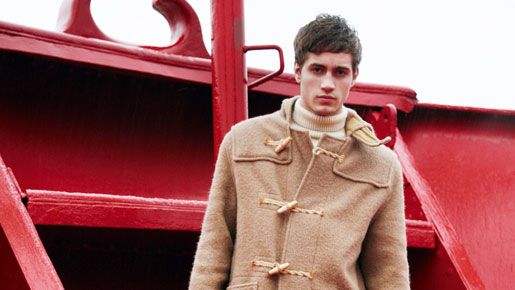
It’s not so surprising that some men won’t let a duffle anywhere near their wardrobes. But those averse to the idea of donning duffle should think again. Many women find a man dressed in this decidedly un-macho piece of clothing irresistibly appealing, as it gives the wearer a quietly confident air spiked with a bohemian edge. The duffle may be the antidote to the sharp suit, but it’s no less cutting and a smart alternative for the business traveller enjoying the world’s colder climes.
The duffle now and then
Trends come and go and are fleeting by default. Not so the resurrection of the duffle coat. The garment has enjoyed a definite boom in recent years, and has succeeded in re-establishing its status as a cult classic. All manner of brands have responded to the charms of the duffle coat: Prada, APC, Raf Simons, YMC and Band of Outsiders are all in on the act, putting their own spin on the toggle-adorned garment without tampering too much with its original silhouette − something that would be considered sacrilege of the highest order. So where did the garment that the fashion industry has taken to its heart begin its days?
All manner of brands have responded to the charms of the duffle coat, putting their own spin on the toggle-adorned garment without tampering too much with its original silhouette
The name itself originally referred to a heavy woollen cloth created to withstand bitter winter climates; significantly, the material was manufactured in the Belgian town of Duffel. The origins of the coat style can be traced back to World War I, when it was adopted by the British Navy to protect officers from the harsh winds gushing in from the Atlantic and the North Sea.
Aside from offering warmth, every aspect of the garment was conceived for practical reasons. The toggles were engineered specifically to allow the wearer to fasten them even in the event of wearing thick gloves. The hood, meanwhile, was shaped and cut to fit over peaked Naval caps.
The coat as we know it today − featuring a double faced fabric with a checked back, and fitted with horn toggles and leather fastenings − emerged in the 1950s courtesy of Gloverall, a UK-based company that is widely regarded as the original duffle coat contender. Striking a balance between modernity and traditional values, the label is stocked by some of the industry’s most notable retailers and online stores, including Urban Outfitters, Tres Bien Shop and Oi Polloi. While many brands struggle to convincingly communicate an interesting past, the story behind Gloverall is genuinely intriguing.
A time for celebration
In 1951, Harold and Freda Morris − a pair of shopkeepers who originally set out to sell cotton, leather, gloves and overalls − were approached by the Ministry of Defence to help dispose of its surplus supply of World War II duffle coats. Harold Morris welcomed the initiative with open arms and named the new company Gloverall. Having perfected the art of the duffle coat over many decades, the label offers its own ranges, and also produces duffle coats for a slew of external brands.
This year, Gloverall is celebrating its 60th anniversary, and to mark the occasion, a special collection has been brought out that includes an Anniversary Duffle, of which only 60 individually numbered pieces have been released. As a nod to the company’s humble beginnings as a designated duffle coat producer, the pattern of the garment has been sourced from Gloverall’s archive dating back to the 1950s. A wholly English affair, the coat has been constructed using British Wool woven by Fox Brothers, a UK-based manufacturer of fine wool established in 1772.

